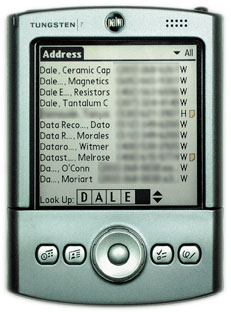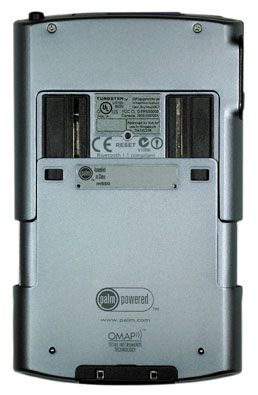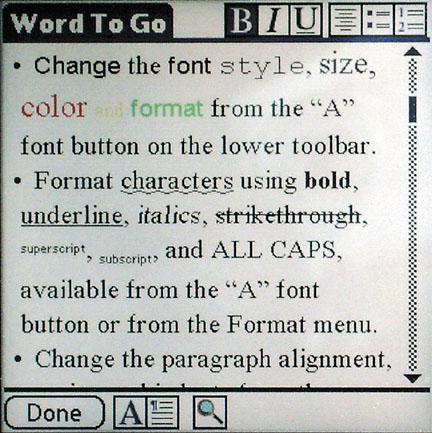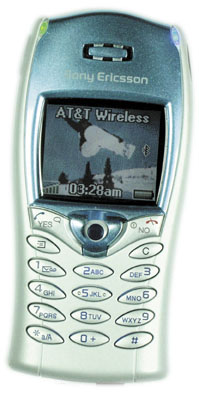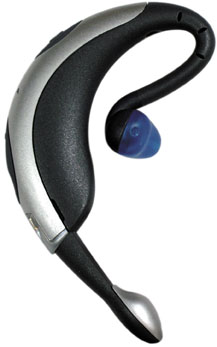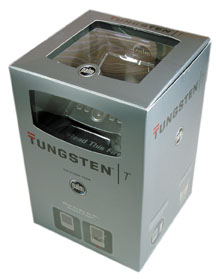

Current Cover
Recent issues






|
|
|
|
|
|
Palm Tungsten TPalm strikes back with totally new hardwareby Shawn Barnett Posted November 13, 2002
As I left the Sony meeting that day, having seen the amazing NX70V, I was left wondering if Palm would offer something that would compete in a revolutionary way, or if it would be just another incremental upgrade that tried to maintain the simplicity and that Palm V mystique at the expense of more advanced features. One look at the Tungsten T told me this was no Palm V. Yes, it was the same as we'd all seen on the rumor sites, only without the keyboard. The OS and its refinements are what have truly impressed. It is clear that Palm is moving in a different direction from Sony, or even Handspring. Each now offers their own take on what a handheld should do, as well as how it should look and function. After I saw all the features of Tungsten T, I paused in amazement and said, "Palm is back." While it is handsome in its own right, the Tungsten T does take some getting used to. Not only is it a whole new look externally, in many ways it's a new way of using a PDA. Palm clearly is no longer resting on its laurels; they're working hard to make the Palm both easier to use and more useful as an electronic assistant. They've made some great strides.
As I say, this is no Palm V. It doesn't even try to look like one, as the m500 series did. Its most notable physical feature is its slider mechanism. Closed, it is just slightly smaller than the new CLIE SJ series and Treo 90 handhelds, and feels solid like a nice digital camera. There is a slight looseness on the bottom piece, but it's far more solid than I expected. Pulled open, it's about as big as a CLIE T665. To open it, you just pull on the bottom piece, and the unit comes on by default. You can also set it to go off when closed. Opening the unit reveals the Graffiti area, something that is, for me anyway, essential to using the unit. The body of the Tungsten T appears to be magnesium front and back, with black plastic top, bottom, and sides. Its bluish finish is classy and all business. The four application buttons across the bottom are the standard fare. They're my least favorite element from a design standpoint on a product that is otherwise excellent, but they are indeed minimalist and their shape does go with the rest of the shapes on the device. The newcomer is the five-way navigation disk that replaces the two scroll buttons. This is a clever innovation, often seen on digital cameras, that allows easier navigation in many applications. The Address Book, for example, has been modified to allow quick lookup with a feature that generally requires only a few presses on the disk, depending on the size of your database. Pressing on the center button activates the disk in most applications, and pressing it with the unit off activates the built-in World Clock, an idea borrowed from the Palm m100. Across the top of the screen from left to right is the status light, Tungsten logo, the new Palm "ball" logo, and holes for the speaker. Yes, a Palm-branded device can finally record and playback voice memos. With a 128MB SD card I can record over 450 minutes, provided the battery holds up (with all these new units I haven't had a spare 450 minutes to answer the question). Included with the unit is a clear plastic cover that harks back to the Visor handheld. It grips on the sides instead of the top and bottom, but it's essentially the same idea. It can snap on the front, and likewise snap on the back for storage. I'm not really fond of such solutions-just a little too fiddly for me-but it does work, and it looks nice.
The top of the unit has the power button on the left, an SD slot, IrDA port, and a new stylus silo with a nifty pop-up stylus. You just press down on the protruding top of the stylus and it comes up enough for easy removal. We haven't seen a fun stylus like this since the Apple Newton Message Pad 110.
On the back the slider mechanism is better revealed. Palm went through some trouble to maintain compatibility with the Universal connector, and it's a good thing. Now was not the time to change connectors. The Tungsten T, in fact, ships with the very cradle design that the m500 shipped with. Speaking of which, the back label reveals that this is the m550 despite its complete lack of resemblance to the other m500 devices. Sliding the unit open shows part of the plastic and metal mechanism that gives the slider its firm feel. The reset button is also concealed here, and lo and behold it can be activated with the stylus tip instead of a special reset pin. We've HandEra to thank for pioneering this completely logical innovation. On the left side is the record activation button, in what appears to be the standard location for such buttons on Pocket PC devices. Just nearby is the small mic hole, and above that is an earphone jack, presumably for audio playback of recorded messages, but also likely for third party MP3 solutions. ScreenPut simply, the screen is gorgeous. 320 x 320 is not new to Palm OS devices, but Palm did some things just a little better than the early CLIEs did. First of all, the fonts aren't razor thin, they're near the same thickness as the old font, only less jaggy. The result is attractive and easier to read very quickly. All of the icons have been redesigned to work with the higher resolution, also offering a three dimensional look. Instead of being backed by big blue dots, the blue dots are now little shadows beneath the icon. It looks nice, and distinguishes this Palm OS version from Sony's.
The screen is bright and contrasty, looking attractively metallic, both indoors and out. It is a frontlit TFT at a time when most companies are switching to backlit transflective TFT, but it seems none the worse for it. Another interface change is the sound. Pips and beeps are different, taking me way back to the Seventies and that original Pong game my sister and I were addicted to. Alarms are the same, but they seem to be generated with polyphonic sound. Palm will likely let a third party add sounds to take advantage of this feature. I'm hoping they'll take steps to challenge Sony in this area soon. Little things mean a lot. ProcessorThe real advancement in the Tungsten T is its processor, which is substantially more powerful than its 33MHz predecessor, the Motorola Dragonball VZ. Palm OS 5 will only work on a variant of the ARM processor, and Palm has chosen the Texas Instruments OMAP1510 for this device. There are several others to choose from, but the OMAP is different in that it integrates a digital signal processor to augment the power of the specially-modified ARM processor core. It was unclear at first what the clock speed of this processor was, but TI's own site lists this processor able to run at a maximum of 175MHz; a reader emailed with evidence that it runs at 144MHz, and sources at Palm have confirmed this. Palm likely downplayed this issue because most people are very influenced by clock speed, and many competitors will be running 200MHz processors. More RAM than 16MB might have helped compete, a strategy that might work in the future. Regardless, the OS is incredibly snappy. There simply isn't a pause when looking up a phone number. It just comes up before you can remove the stylus. Searches take fractions of a second rather than many seconds, and even HotSync is once again faster than before. I also notice that something has been improved with the Graffiti recognizer, since I'm getting far better and faster recognition than before. I have to say, it's almost as if the Tungsten T is guessing my next move, it's so fast, and that makes for a pleasant experience. Bluetooth
Perhaps most impressive is the Tungsten T's integrated Bluetooth radio and the software that supports it. Palm touted this vision long ago, and I reviewed their first go-round two issues ago with the Palm m515 and the Palm Bluetooth SD card. It worked, but not well enough that it topped the Handspring Treo 270 in speed or convenience. But the Tungsten T would be a worthy opponent. Palm worked with Sony-Ericsson to make the marriage between the Tungsten T and the T68i GSM/GPRS cell phone an easy one. Now I can confidently say it works as originally envisioned, tight and quick. Once I have the two devices paired, which is done with a smart and easy interface for both pairing and data linking (Web browsing, email, etc.), all I have to do is look up a number and tap on it, and in three seconds it's dialed and the call's in progress. Not bad. I tried it with the Jabra Bluetooth headset (US$99) as well to complete the picture, and it was amazing. No more delay in the handoff from phone to headset as I experienced with the HBH-15 headset in my earlier test. Later I did have trouble with the Jabra headset not transferring the call at first, then grabbing the call from me at random. This is likely an issue with Jabra's prototype unit. The important part is the extreme speed in handoff between PDA and phone. It used to be that you had to select the method you wanted to use (Bluetooth or IrDA), wait for the Palm to find the other device, select the device, and only then did dialing commence. Now it's just a tap and the Palm does its work in a flash.
The same is true for data calls. Very fast connections with my AT&T Wireless account. Palm's new WAP and Web browsers work well, though I'll use the Web browser more than WAP. SMS is an absolute no-brainer. It just works, and works quickly. Palm has also renamed MultiMail as VersaMail and included it in the bundle. Again, flawless execution here. A great program has been integrated into Palm's overall product vision. We're finally seeing the fruits of purchases and plans made long ago. Really, I'm pretty impressed with the integration. Any previous Palm user with any experience will have no trouble setting up any of this, and I think the complete novice will do fine just following the instructions. It went so easily for me, I was a little freaked out. This is a computer, right? But it all just worked, so I just started using it. It almost felt like a Mac, and until that Jabra headset started to fail, I was extremely pleased with the combo, getting rather comfortable with my wireless communication trio (pun intended). Even setting up Bluetooth HotSync was simple. I'm now able to Bluetooth HotSync with both my PC and Mac via separate Bluetooth connections. I just select the connection on the HotSync screen and press the button. It's a lot slower than cradle HotSync, however, so it's better used for quick updates, not complete re-installs. The Tungsten T comes bundled with some useful software, including Documents to Go with some excellent fonts that really show off what a 320 x 320 screen can do. Times Roman renders better than it does on a notebook computer, so I'm thinking that's more than satisfactory. The bundle of Documents to Go makes the T compatible with desktop Word, Excel, and Powerpoint.
Symbolically, the new device comes in all new packaging, a complete departure from boxes past. It's a metallic gray tower with the Palm floating in a clear plastic support. Not bad, very classy. It conveys the sense that this is a different product from Palms of the past. While the software that currently ships with the Tungsten T is running in 68K emulation, the potential is huge for all manner of powerful applications to come to the Palm platform. It's nice to see the fruits of the work Palm has been doing in secret. The Tungsten T with its advanced processor and Palm OS 5 is now poised to enter areas previously the domain of the Pocket PC. It'll be interesting to watch as the power of the proven Palm OS design takes on the business world with the processor and features many have held out for. The more time I spend with the T, the happier I am that Palm waited until the time and technology were ripe, because they really got it right. |
